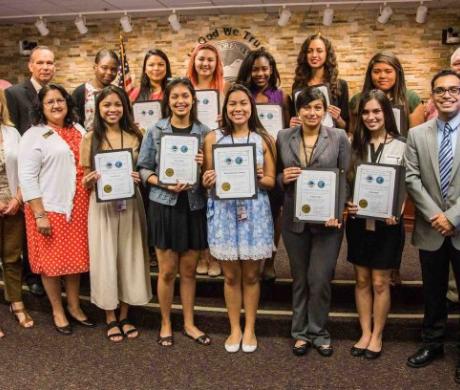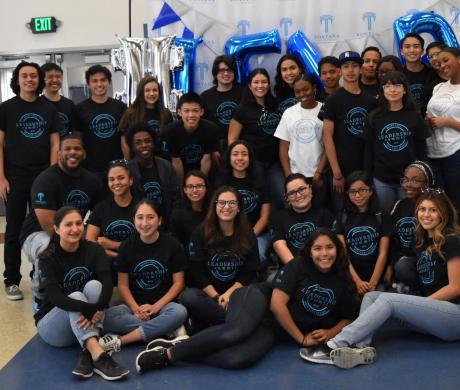Sparking a Student’s Lifelong Interest in Local Government
Randi Kay Stephens is associate program manager for the Institute for Local Government and can be reached at rstephens@ca-ilg.org.
Each fall, students head back to school to gain new skills and make lifelong memories. The Institute for Local Government (ILG) wants to make sure that local government plays a part in students’ fond and distinct memories that can last a lifetime.
ILG’s recently revised Picture Yourself in Local Government (PYLG) curriculum is now available for local agencies to use with students of all ages. The latest update includes interactive activities to help your constituents learn about the role of local government and the wide range of people responsible for operating a local agency.
Updated Booklet Can Simplify Tours, Orientations and More
The PYLG curriculum was designed with the K–12 classroom in mind, but it can also be used as a resource for your city with:
- Content to include in scripts for student tours of city offices;
- New staff and intern orientation materials that cover local government basics;
- Background material for city staff to use when serving as a guest speaker in a classroom;
- Handouts to educate boards, commissions and leadership academies about local government structure and functions; and
- Easy-to-understand language tailored for youth and the public.
Generating Excitement for Local Government Careers
PYLG was first developed in 1994 as a unique student guide for local government. The new version of PYLG aligns with the California Department of Education’s recently revised History-Social Sciences Framework.
Lemon Grove City Manager Lydia Romero has a long history with PYLG. She was a management analyst in the 1990s and used the original PYLG curriculum to inform dozens of students touring City Hall. Several years later at a League of California Cities Annual Conference & Expo, Romero was reintroduced to one of those students who had gone on to serve on a city council.
“Planting the seeds of interest in local government takes time,” said Romero. “I’m delighted the information I presented using PYLG sparked enthusiasm for that student to get involved and play an active role in her community.”
PYLG is available for your agency and education partners to use free of charge. City staff, educators and the public can use the curriculum to explore the nuances of local government’s history, structure, players, services and finances. The curriculum also emphasizes the many ways youths and adults can actively participate in local government through the policymaking process or by working in an agency to implement programs and services. PYLG was designed to encourage critical thinking and help participants engage in meaningful discussion about topics such as how:
- Local government can make life better for people;
- Local government leadership is structured;
- Citizens can enact change;
- Local government meets community needs; and
- Programs and services are funded.
Many adults currently serving in local government wish they had learned about essential services, administration and governance earlier in their academic careers. If your agency would like to ensure that the next generation of young leaders has an opportunity to learn about local government before they leave high school, download the updated PYLG materials online at www.ca-ilg.org/pylg.
Working together, local government leaders and education institutions can collaborate to lay the groundwork for a lifelong interest in local government.
How Are You Connecting With the Next Generation of Community Leaders?
Access ILG’s Governments Engaging Youth toolkit to learn how to create or expand a civics education or internship program. Visit www.ca-ilg.org/geytoolkit for more information.
Related Resources
Connecting Youth and Civic Leadership
New Toolkit Helps Local Governments Engage Youth
Amplify Your Community’s Voice by Fostering Future Leaders
Connecting Youth With Democracy
Cultivating an Inclusive and Diverse Future Workforce
Milpitas Initiative Targets Workforce Development
Cities Collaborate to Help Give Kids a Running Start for School
The text and table below are excerpted from the Institute for Local Government’s Youth Commissions Briefing Paper #4: Connecting the Next Generation with Local Agency Careers: Ideas for Encouraging Youth to Enter Public Service, available free at www.ca-ilg.org/ConnectingtheNextGeneration.
Matching Personal Interests With Possible Careers
The table below can help frame job and career opportunities in local public agencies and public service in a way that young people can easily relate to and understand. This table can be used as a handout and as the basis for a discussion with youth about the available options that are suited to an individual’s various interests, talents and abilities. The next steps may be to discuss briefly the roles of various departments at the city or county level and provide background information to get youth thinking about potential career options that may interest them.
|
If you enjoy or are interested in: |
You might like working in this area: |
|
Helping people solve problems and find solutions |
Community development Economic development Elected leader’s office staff Housing Human resources Human services Law enforcement Management or administration Neighborhood services |
|
Operating heavy machinery |
Fleet maintenance Parks and recreation Public works or engineering Urban forestry |
|
Managing money and investments |
Accounting or finance Auditing Budget operations Revenue services |
|
Crime-solving and crime investigation |
City Attorney’s or County Counsel’s Office Criminal justice Coroner’s Office Law enforcement |
|
Repairing and maintaining cars, trucks and vehicles |
Fleet maintenance and services Public works or engineering Transportation or transit |
|
Solving complicated math problems |
Accounting or financial management City or County Clerk’s Office Information Technology services |
|
Extreme sports |
Emergency services Firefighting Recreation |
|
Working with computers |
Geographic Information Services (GIS) Information Technology |
|
Gardening |
Landscaping or parks maintenance |
|
Working with children and young people |
Community services Health services Library services Parks and Recreation Social services Teaching Volunteer services |
|
Writing articles and working with the media |
Public Information Office |
|
How communities, facilities and buildings (such as parks, schools, libraries and cities) are planned, designed and built |
Engineering and construction Geographic Information Services (GIS) Law enforcement (Crime Prevention through Design) Landscape Architecture Parks and Recreation Planning Department or Building Department |
|
Doing research |
Administrative office staff City Attorney’s Office County Counsel’s Office District Attorney’s Office Elected leader’s office staff Law enforcement |
|
Driving a truck or bus |
Parks and Recreation Public Works Transportation or Transit |
|
Elections and how they work |
City or County Clerk’s Office City Attorney’s Office County Counsel’s Office Elected leader’s office staff |
|
Website design and maintenance |
Geographic Information Systems (GIS) Information Technology Services Library Services Public Information Office |
|
Traffic systems and how traffic is managed |
Geographic Information Systems (GIS) Public Works |
|
Alternative fuel vehicles |
Fleet management |
|
Renewable energy and energy efficiency |
Facility Construction Planning and Building Departments |
|
Environmental protection and sustainability |
Planning and Building Departments |
|
Being outdoors |
Community Services Parks and Recreation Physical Education Public Works |
|
Working with adults, seniors and the aging population |
Community Services Health and Human Services Library Services Parks and Recreation |
|
Preparing for emergencies |
Elected leader’s office Geographic Information Services (GIS) Human Resources Manager’s or Chief Administrator’s Office Planning Department Public Works |
|
Landscape design and maintenance |
Community Services Grounds and Facilities Parks Public Works |
|
Medical issues and health care |
County hospitals Health services |
|
Management and general administration |
Manager’s or Chief Administrator’s Office |
|
Nature, natural resources and the environment |
Parks Planning Department Public Works |
|
Energy efficiency |
Planning Department Public Works Utility Department or District |
|
Water |
Environmental Health Public Works Utility Department or Utility District |
|
Recycling and solid waste |
Public Works Engineering Environmental Health |
|
Working with animals |
Animal care services Animal control Law enforcement (K9, Mounted Patrol) Public Works |
|
Working with people with special needs |
Adaptive Services Health and Human Services Human Resources Library Services Parks and Recreation School Construction |
|
Food Services and Nutrition |
County Health Offices Health and Human Services Parks and Recreation School Facilities |
This article appears in the August 2019 issue of Western City
Did you like what you read here? Subscribe to Western City





